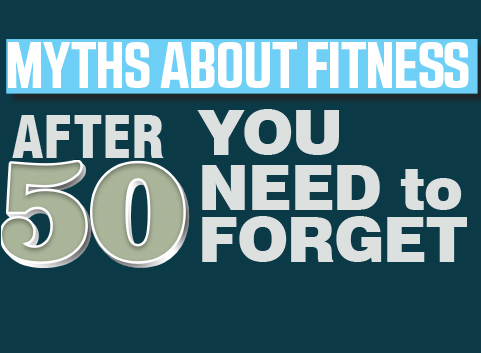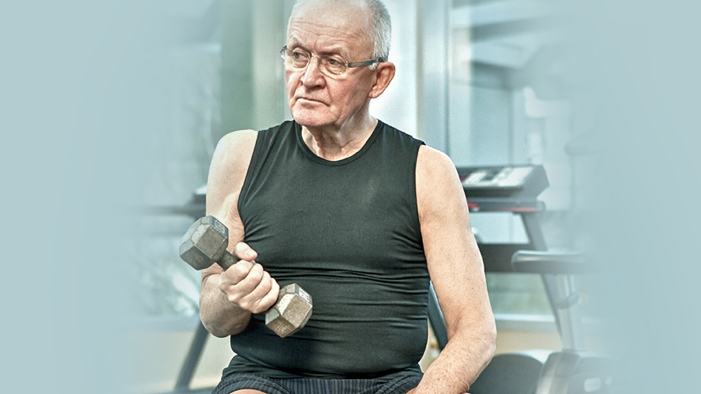Home Workouts & Training myths about fitness
Myths About Fitness

By Gaurav Bhandari
AFTER 50 YOU NEED TO FORGET
“BEING HEALTHY IS NOT A FAD OR A TREND IT’S A LIFESTYLE”

Most of us tend to be more active in our younger years. But experts agree that the need to exercise—both strength and cardio—only increases as we age. A lot of people complaint that with age their body response has gone slow and that they are not able to do what they used to do when they were teenagers or in there 20’s, or 30’s etc. Specially with age we start focusing more on our careers and family and give fitness a back seat. Its very important to strike a balance in life. Its not as easy but having a healthy body will give you a healthy mind.
We forget about nutrition because of our lifestyle and with time our body changes and one fine day we wake up and realize that how drastically our body has changed.
Research indicates that physical inactivity leads to significant increase in visceral fat(unhealthy fat), which can lead to cardiovascular diseases, diabetes and other metabolic syndrome. Visceral fat is located around the organs inside the belly and is deeper in the body than subcutaneous fat, which lies under the skin.
“Lean muscles boost your metabolism and strengthens your overall bone density, both of which decline with age. If you’ve maintained an exercise routine through the years, you’re on the right track when it comes to scoring impressive health benefits. But all is not lost if you’re just starting to work out post-50.
Here are some myths and truth about fitness after 50.
YOU CAN’T BUILD MUSCLE AFTER 50.
“While you may not be able to build muscle as easily as when you were younger, you still can most certainly build muscle. Physiology does not change so much that your body will not respond to strength training. In fact, there is research showing that you can build muscle even in your 90s!” well if you survive till then of course, which you could probably do if you have a healthy lifestyle and listen to your body. One of the best ways of building your muscle and retaining it, regardless of your age, is by ensuring that you’re getting adequate protein in your diet.
YOU CAN’T LIFT HEAVY WEIGHT.
So as long as you don’t have any injuries or limitations when it comes to range of movement, you can add weight on top of strength training movements. “The evidence clearly shows that higher intensities are more beneficial for reducing sarcopenia (muscle loss) and improving bone density.However, that the idea that older people should use heavier loads is unfounded and not true. There is no safe weight for somebody to be lifting that can be judged from an external factor such as age or gender. “Heavy” is a completely relative and individual term. What is an appropriate weight for you to lift is based on one thing only: what weight YOU are able to lift safely.
One of the best kept secrets of strength training for older adults is that there are so many different ways to perform the basic movement patterns. If one lift is too challenging, you can still get all the many strength and health benefits of training by performing a slightly different variation that better suits your body. Good strength coaches have the skills and experience to help with finding the right movement for you. So always go with a certified and experienced trainer.
YOU SHOULD EXERCISE SLOWLY.
It’s important to move slowly at first in order to master any movement or type of workout. But, your goal should eventually be to add speed. “As we age, we tend to lose , muscle fibers, which is typically due to inactivity or lack of stress on these tissues. “These muscle fibers are what help us move heavy objects. To stimulate these fibers, one of the best things you can do is lift weights (weight training). Doing so can help you boost your agility and reaction time.
YOUR JOINTS CAN’T SUPPORT WORKOUTS.
It’s easy to blame certain ailments for your inability to exercise as you get older. But, according to studies exercise is often the answer to a lot of knee or joint-related issues. “It’s worth starting with some small stretches and building up strength from there. You should see improvements in your stiffness and overall mobility.”
YOU BECOME LESS FLEXIBLE.
Regardless of age, anyone who stops stretching and exercising will become less flexible over time. So, it’s a total myth that after 50 you magically become inflexible. “The truth is that when people say this, what they really mean is that they’re a little bit stiff. “Incorporating regular stretches and yoga into your exercise routine is a sure way to increase flexibility and strengthen your body from within.”
YOU CAN’T LOSE WEIGHT.
It’s true that certain physiological changes will result in a slower metabolism the older you get. However, this is often an excuse used to blame all weight management issues. “As we age, we typically move much less than we had in previous years. This slowed movement is more responsible than the slowed metabolism, we just aren’t as active as when we were younger. It’s true that you’re faced with some disadvantages as you age (when it comes to weight loss). But it’s not a simple problem of slowed metabolism.
Don’t let your age or the myths surrounding your age get in the way of your health. There is no reason to assume that you can’t be your fittest and happiest self at any age thanks to fitness after 50. If you have any concerns about your individual health or body, check in with your doctor and training coach to come up with a fitness plan that works for you.
With every exercise plan no matter what the age its very important to eat a nutritional and healthy diet. Always consult a nutritionist and make a healthy restart to getting back in shape.
Make fitness a part of your life, have a healthy life , go for walks with your partner in life take up some extracurricular activity. Don’t you wish to play with your children or grand children? Be a leader by teaching other and your family not only about morals in life but also about the importance of fitness. Be exemplary.
LIKE THEY SAY AGE IS JUST A NUMBER.
